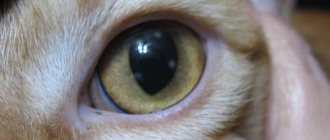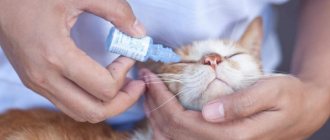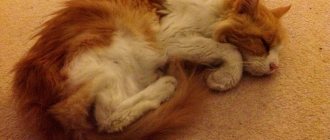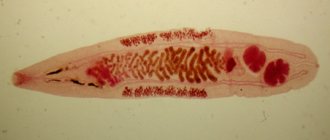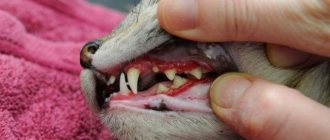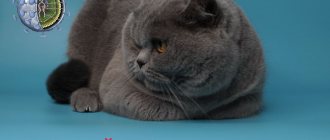Symptoms of otitis Causes of otitis in cats Parasitic otitis Bacterial otitis Immune-related otitis Otitis caused by the presence of a tumor or foreign body Diagnosis of otitis Treatment of otitis in cats Otitis in cats is an inflammation of the ear canal.
According to the anatomical principle, external, middle and internal otitis are distinguished - depending on which ear was affected - anatomically, the outer, middle and inner ears of a cat are distinguished. The outer ear includes the pinna and the external auditory canal, where the cerumen glands are located. A cat's middle ear includes the eardrum and the auditory ossicles (hammer, incus, and stapes). The inner ear is an auditory labyrinth, and the organ of Corti, which directly transmits sounds, is also where the vestibular apparatus is located, so internal otitis is often accompanied by disturbances in its functioning (for example, a cat walks with its head tilted to one side).
According to the etiological principle, that is, the reason that caused otitis media in a cat, the following types are distinguished:
- parasitic otitis,
- microbial (bacterial) otitis,
- immune-related (allergic, atopic, autoimmune),
- otitis caused by the presence of a tumor in the ear canal or a foreign body, otitis due to endocrinopathies,
- Chronic viral infections in cats, leading to a decrease in general and local immunity, also contribute to the development of otitis media.
Otitis is accompanied by discharge from the ear - exudate. The nature of the exudate may be different for different etiological reasons, depending on what caused the development of otitis media:
- Dry dark brown discharge is characteristic of otodectosis
- Liquid brown - for bacteria and fungi
- Purulent yellow - gram-negative microflora
- Gray-yellow curdled exudate - fungal pathologies
- Yellow-brown waxy - seborrheic and ceruminous otitis
Symptoms of otitis media
Frequent accompaniments of otitis media are pain, itching, redness of the skin on the inner surface of the ear, and increased discharge from the ears. A cat can often scratch its ear, until bald patches and wounds appear on the auricle, and does not allow the ear to be touched. If a cat shakes its head, this indicates discomfort in the ear canal area.
“Dirty” ears, that is, increased secretion of exudate, is also most often a symptom of otitis media. Normally, in cats, discharge from the ears practically does not accumulate, the auricle is clean. If you often need to clean your cat’s ears, you should consult a dermatologist to determine the cause of such an increased amount of exudate.
Inner ear diseases
These ailments are the most serious. They are difficult to identify, it is difficult to even imagine how to treat ear diseases in cats, since the picture of the course can be blurred, the shape can easily change, affecting either the outer, then the middle and inner zone of the auricle.
Mostly otitis media occurs. This is an inflammatory process that has various causes. 3 types are classified: external, middle, internal otitis. With external inflammation, the symptoms are similar to otodectosis - redness, wax in the ears, and various irritations. But in this case, the pet does not itch as often.
If the detection of the disease is delayed, hair may fall out and pus may appear. Causes of infection:
- Injury or splinter;
- Hypothermia;
- Fungi;
- Sulfur plugs;
- Allergy;
- Infections.
Various microorganisms and viruses can lead to inflammatory processes. Otitis media forms if the auditory tube is affected. Air ventilation is impaired. This type is very rare.
Self-treatment is strictly contraindicated. The disease must be treated by a veterinarian, since with the wrong approach there is a very high risk of complications.
Parasitic otitis
The most common cause of the development of both parasitic otitis media and otitis media in general in cats are mites of the genus Otodectes. The disease they cause is called otodectosis. Signs of this disease include increased dark brown, dry discharge from the ears, as well as itching. Often, bacterial otitis caused by secondary microflora (bacteria and/or fungi) develops against the background of otodectosis. Otodectosis is contagious and can be transmitted from cat to cat or from cat to dog and vice versa. This disease does not pose any danger to people.
Risk factors
Be sure to contact your veterinarian if your cat shows signs of otitis media. When making a diagnosis, the doctor takes into account the following factors:
— Animal nutrition (possibility of allergic reactions); — The shape of the ears and the thickness of the hair on them (in lop-eared kittens, more favorable conditions are created in the ears for the development of pathogens); — Treatment carried out prior to the disease; — Treatment against parasites; — Frequency of bathing (possible exposure to water); — Proper ear cleaning.
Bacterial otitis
Bacterial or microbial otitis is almost always secondary, due to allergies or injuries to the ear cavity. One of the fairly common causes of ear injury in cats is improper cleaning using cotton swabs. Cats have a completely different structure of the auricle; when using cotton swabs, the ear canal is not cleaned due to its anatomical features. The ear canal is curved, so when you try to clean the ear with a cotton swab, all the secretions are compacted, their outflow is disrupted, and this provokes the so-called congestive otitis media. Active cleaning with a cotton swab often causes injuries; cotton fibers remain in the ear, which can also cause inflammation.
Ceruminous otitis media develops against the background of irritation of the skin of the external auditory canal. It is characterized by increased release of sulfur. Frequent ear cleaning, especially using cotton swabs, also contributes to its development. The more the wall of the external auditory canal is irritated, the more the glands work.
Prevention
In order to minimize the likelihood of otitis media, the following preventive measures must be observed:
- Clean your ears only when they become dirty. If you are unsure whether to clean, consult a professional. Cleaning your ears too often can lead to ear infections;
- To clean ears, use specialized hygienic solutions intended for animals. Should be used according to the instructions, using the optimal amount of lotion;
- Do not use cotton swabs for cleaning. Gently clean only the visible parts of the ear using a cotton pad;
- Regularly treat your pet for ectoparasites. This will eliminate parasitic and allergic factors.
Immune-related otitis
Otitis can occur against the background of various types of allergies. Most often, as a result of an allergy to flea saliva, this is also how atopic allergies (to environmental factors, such as dust) or food allergies manifest themselves.
There is such a disease as proliferative and necrotizing otitis media in kittens. It develops only in kittens and is manifested by erosions and ulcers on the skin of the ear canal and the appearance of areas of necrotic tissue. As a rule, with this disease there is no pain syndrome and the kittens’ ears do not bother them at all. The disease is not contagious. It is easily treated with immunosuppressants, as it is immune-mediated.
Also, otitis in cats develops against the background of an autoimmune disease such as pemphigus foliaceus. In this case, not only the ears are most often affected, but also the scalp and other areas.
Causes of the disease
Like any other disease, otitis media must have its own causes:
a) parasites – waste products of insects cause irritation and inflammation of the ear; b) foreign bodies - they get during games and walks in the grass, and it can also be water that gets in while swimming; c) skin atopy is a chronic disease caused by allergies or hereditary predisposition.
Most often, otitis media occurs due to parasites and poor nutrition, as well as improper care of the pet’s ears by the owner.
Otitis caused by the presence of a neoplasm or foreign body
Otitis develops when foreign bodies enter the ear. Often the cause is the same cotton swabs, which break off or cotton flakes separate and get into the ear canal. Also, the cause may be grass seeds - this is typical for cats walking in the country.
It is not uncommon for cats to develop neoplasms of the ceruminous glands (glands that secrete sulfur). Such tumors are called cerumin. If the tumor opens and becomes infected, then purulent, and sometimes purulent discharge mixed with blood, can be observed from the ears. In such cases, it is necessary to perform otoscopy to visualize the tumor.
.
Preventive measures
As a preventive measure, you need to regularly clean your animal’s ears. To do this, you must use products prescribed by your veterinarian. Cleaning should not injure the hearing organs; it must be done very carefully.
It is necessary to periodically check and examine your tailed friend, and consult a clinic when the first signs of various ailments appear.
DIAGNOSIS OF OTITIS
There are many causes of otitis, and treatment will vary significantly, so it is necessary to determine what exactly caused the inflammation. This can only be done by a dermatologist; it is impossible to do this at home - you need a laboratory.
The primary diagnosis of otitis media includes:
- inspection,
- otoscopy,
- taking a cytological smear from the external auditory canal,
- scraping and trichoscopy in case of demodicosis (rare).
Additional methods are used to diagnose neoplasms or otitis media:
- video otoscopy under anesthesia,
- radiography,
- MRI/CT examination.
In some cases, it is necessary to take a bacterial culture from the ear to determine sensitive flora.
Otitis media in cats can develop as a primary disease, unlike dogs, in which otitis media most often develops against the background of external otitis media when the eardrum is perforated; in cats, the integrity of the eardrum does not exclude otitis media.
The causes of otitis media in cats include: viruses, mycoplasmas, bacterial infections from the respiratory tract, nasopharyngeal polyps. Additional diagnostics are required to determine the causes.
Symptoms of otitis media include:
- pain,
- tilting the head towards the affected ear,
- neurological symptoms, as the ocular and facial nerves may be affected.
Video of an ear examination of a cat with otitis media.
Treatment of ear diseases
To make a diagnosis, it is necessary not only to see the picture of the patient’s clinic, but also to take into account various tissue tests.
The doctor will prescribe treatment depending on the sum of all indicators.
- These can be antimicrobial, antiviral, antiallergic drugs, antibiotics and homeopathic remedies.
- The treatment process can be adjusted, especially with regard to fungal infections and mites.
- For hematomas and neoplasms, the help of a surgeon will be required.
Self-medication can only complicate the process. It is necessary to remember not only about the complications, but also about the harm that can be caused to your little friend when using inappropriate medications.
Treatment of otitis media in cats
Treatment comes down to eliminating the etiological factor (antiparasitic drugs, removal of polyp/tumor, immunosuppressants for autoimmune diseases), as well as eliminating secondary microflora and hygiene of the external auditory canal. However, a treatment method that can eliminate the cause of otitis media can be chosen only after consultation with a doctor, who will determine this cause. It is highly not recommended to use any drops at home before visiting a doctor, even as recommended by a veterinary pharmacy - if the integrity of the eardrum is damaged, this will lead to very severe deviations. The doctor will determine the cause of otitis in the cat and select a treatment regimen that can be carried out at home. To sanitize the external auditory canal, you can use warm saline solution or special lotions or chlorhexidine bigluconate 0.05%. Lotions and chlorhexidine can only be used on the recommendation of the attending physician, since if the eardrum is perforated, they also cannot be used. Different lotions have different effects (antiseptic, sulfur dissolution, drying effect, etc.).
The article has already repeatedly mentioned how you can’t clean a cat’s ears—you can’t use cotton swabs or just cotton wool. To properly sanitize the ear canal, you need to completely fill the ear with the solution, massage the base of the auricle, then let the cat shake its head. Remove any remaining dirt from the surface of the ear with a bandage, but not with cotton wool or cotton swabs, since the microvilli of cotton wool further irritate the skin of the inflamed ear canal. You need to treat your ears several times until the dirt stops coming out. This procedure must be repeated 1-2 times a week, in especially severe cases 3-4 times.
(c) Veterinary center for the treatment and rehabilitation of animals “Zoostatus”. Varshavskoe highway, 125 building 1. tel. 8 (499) 372-27-37
Folk remedies for otitis media
Use folk remedies only as an auxiliary treatment. They produce a weak therapeutic effect. The safest is green tea. Strain it through cheesecloth and wipe the cat's ears. Tea has an acaricidal and disinfectant effect.
The same effect is obtained from collecting herbs from St. John's wort, lavender, medicinal chamomile, birch leaves, and string . However, do not use traditional methods of therapy. They can reduce the effectiveness of drugs and cause negative reactions in the pet’s body.
Complications
The course of otitis media can often be accompanied by complications. In some cases, a slow progression of the disease is possible, which does not make itself known in any way. This development of the disease ends in chronic inflammation of the ear.
Among the complications are:
- paralysis of the facial nerve (sagging eyelids, lips, changes in facial expressions);
- meningitis (the cat is in shock, vomiting profusely, fever);
- purulent inflammation (fluid is released from the ear, an unpleasant odor begins to emanate from the cat);
- deafness.
